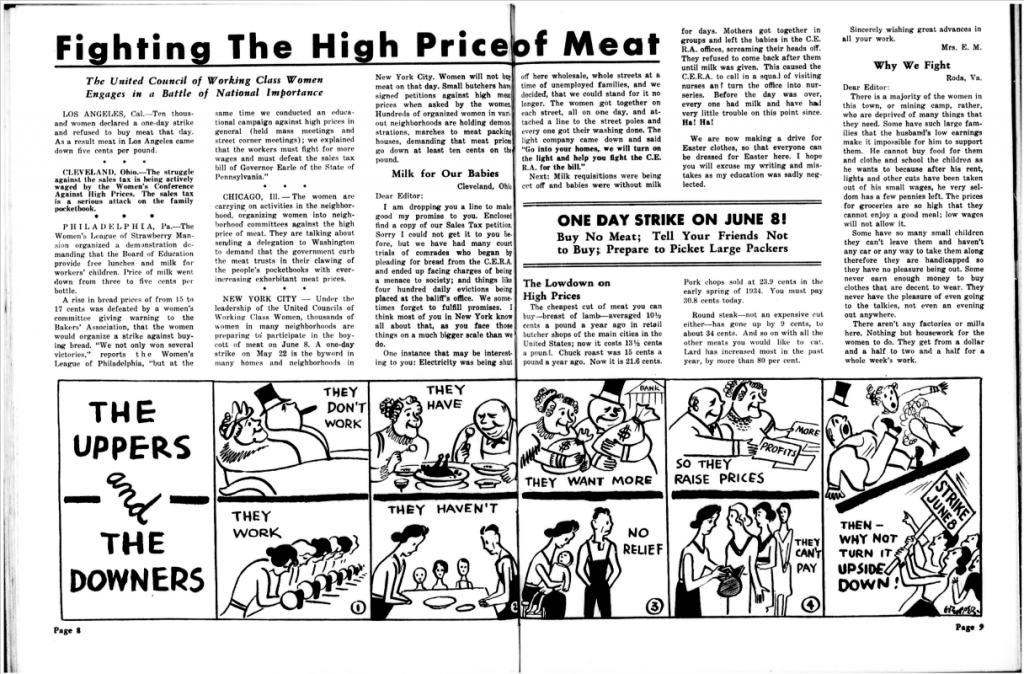Background
In many ways, the Great Depression placed an unfair burden on women. Many Americans—including those shaping government policies—felt women could best help the nation by staying at home. Women were expected to do more with less and stabilize family life in unstable times. Most wives and mothers shouldered these burdens, but they did not necessarily do it quietly.
Many housewives saw unregulated capitalism as the enemy to the home. Decades of Progressive Era politics prepared them to take action. Many of the women involved in these efforts were former working girls who toiled in factories and participated in labor unions when they were single. They were often influenced by New Deal policies and communist ideals. As prices for meat, milk, bread, and other staple foods increased, their fury at big business grew.
Militant housewives held meetings, led marches, and organized protests. In one extreme example, mothers brought their hungry, screaming babies to a relief office and refused to leave until they received help. In another case, Chicago housewives broke into a warehouse and set piles of overpriced meat on fire. The most common strategy was boycotting. Housewives did most of the shopping for the family. If they did not spend money, the economy suffered. Women collectively boycotted certain products or stores to protest high prices. By working as a unit, women forced businesses to change their practices in favor of working-class families. Although these women tapped into current trends in organized labor, they were part of a long tradition of American housewives protesting the price of bread and other household basics.
About the Document
The Working Woman was a magazine published by the Communist Party USA between 1929 and 1935. This two-page spread appeared in the June 1935 issue. The political cartoon along the bottom makes the case for a national meat boycott that summer. Cartoons were an especially popular way to communicate direct messages in the Great Depression, and were often used by activists and advertisers alike.
The text above the cartoon includes several related pieces:
1) Updates on protests in Los Angeles, Cleveland, Philadelphia, Chicago, and New York appear in the first two columns.
2) The next piece is a letter from an activist about ways housewives in her community took action.
3) Information about the rising price of meat appears under the heading “One Day Strike.”
Vocabulary
- boycott: Refusing to buy from or do business with an organization or business as a form of punishment or protest.
- capitalism: An economic and political system in which all goods and items of value are privately owned, and production and sales are controlled by private businesses.
- chuck roast / round steak: Cuts of beef a person can buy at a butcher.
- communism: A political system in which all goods and items of value are collectively owned and distributed to citizens equally.
- comrades: Peers or companions. Communists often use the term to refer to other communists.
- demonstration: A public display of group feelings or attitudes toward a specific person or cause.
- eviction: Kicking someone out of their home.
- labor unions: An organized association of workers formed to protect workers’ rights and interests.
- lowdown: The basic facts.
- New Deal: President Franklin Delano Roosevelt’s national program for stimulating the American economy during the Great Depression. Included employment, housing, and social service support systems.
- Progressive Era: The period in American history from roughly 1889 to 1920 that was characterized by large waves of activism and social reform.
- unregulated: Not controlled or monitored by the government.
Discussion Questions
- View the cartoon. What is the story being told? How do the top boxes relate to the bottom boxes? What are the protesters fighting against?
- Read the updates on strikes in other cities. What and how are women protesting?
- How do all of these pieces relate to one another?
- Why were women angry at big businesses during the Great Depression? How did they suffer under the capitalist system?
- How did housewives use organized labor techniques to fight against economic hardship? Were they successful?
Suggested Activities
- AP Government Connection: 4.9: Ideology & Economic Policy
- Housewives have used their buying power to shape American politics since the founding of our nation. Compare this resource with the story of the Edenton Tea Party to consider the history of women-led boycotts.
- Progressive Era activist Clara Lemlich was an active militant housewife who organized meat boycotts in the 1930s. Pair this resource with her life story.
- The Communist Party was a growing presence in 1920s–1930s America. Connect this resource to the life stories of other women activists associated with the Communist Party, including Ella May Wiggins and Emma Tenayuca.
- Cartoons were a popular form of entertainment and communication in the 1930s. Have student identify an issue they care about today and create a cartoon using the same six-panel structure. How are the “uppers and downers” of today? What action can “downers” take to fight back?
Themes
WORK, LABOR, AND ECONOMY; DOMESTICITY AND FAMILY; POWER AND POLITICS







